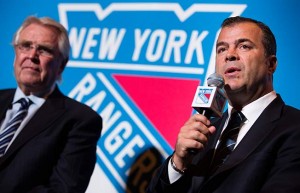As the window to Free Agency opens in a few hours, it got me thinking about the post-lockout economic landscape and how it will affect the Rangers. I actually think it will be a blessing in disguise that the Blueshirts have almost no cap space to work with in the UFA market, with most available resources going to re-sign our own (very talented) RFA’s. Even if another team decides to take Darrell Powe and Arron Asham off our hands, there will likely still be less than three million to play with, and some of that needs to be saved for the deadline.
The biggest wild card GM’s are dealing with is the salary cap in subsequent seasons. All signs point to that cap meeting, or even exceeding the current $70.3 million cap of this past season. With six outdoor games planned for this coming year, revenue seems to be increasing at a rapid rate. The general effect of this type of revenue spike in pro sports (and especially under the new revenue sharing provisions) is that more teams find themselves competing for higher-end assets. Basic law of supply and demand will tell you that this will drive up UFA prices in the future.
We are seeing some of this effect taking place already. Paul Holmgren is either 1.) insane, or 2.) counting on a significant cap spike in 2014-2015, considering he is running the Flyers like he is playing NHL 13. As CBA’s come and go and the economic landscape adapts to the changing market conditions, certain cycles emerge. There is a continuous juxtaposed relationship between risk and asset retention/cost certainty. On one end of the spectrum, teams will not commit to long-term deals, even for their own players to limit the risk of carrying dead weight in a cap system. On the other end is trying to lock up as many core pieces as possible, as early as possible in order to maintain a quality roster and have stability in your budget.
Where these concepts ebb and flow is the in value derived from the contracts/performance of the players. When long-term deals start going bust, it creates a more risk-averse environment, and GM’s are more reticent to hand out those types of extensions. This effect brings the cycle back to drafting/player development. When more teams are spending (in a high revenue environment) teams start to become a little more attached to core assets. If they know that getting a deal done now will be more cost effective than bidding with five other teams in the open market, players begin to be overvalued/over-committed to, since prices of replacement production increases.
Prior to the lockout, franchise defining talent like Crosby or Ovechkin were offered 10+ year deals, which the players would have to be insane to turn down. Now, with the 8-year maximum, the value gap between players closes. No one would ever think of handing Tyler Bozak a 12-year deal, but rumors persist of an 8 (!) year deal in Toronto.
If the economic system was left untouched, it would be reasonably efficient to predict and navigate these cycles. However, with Lockout II bringing the salary cap to the NHL, it turned hockey economics on its head. The new provisions of this current CBA have injected enough uncertainty into proceedings that the waters are further muddied. With this transition, no one knows where exactly in the cycle we are, and it makes UFA decisions all the more risky.
The non-buyout of Brad Richards has been a polarizing subject, and advocates of both sides have a valid and intelligent argument. But with Glen Sather’s UFA track-record, I have to think this forced restraint is a major gain for New York in a weak free agent class and future cap uncertainty. With Henrik Lundqvist, Ryan Callahan and Dan Girardi all becoming UFA’s after this coming season, having that flexibility is going to be incredibly valuable, especially with Paul Holmgren around.
I’m not sure exactly where I’m going with this, but I guess I feel like until we get a handle on the new economics of the NHL, its going to be very difficult to gauge the intelligence of decisions. Even though we probably won’t have an exciting off-season of trades and free agent signings, I think watching from the sidelines until the cap situation becomes more clear, probably saves the Rangers from themselves. It gives the organization future flexibility, a chance to see what we have in some of the younger guys, and doesn’t feature David Clarkson making $6.5 million on our books.
Share:
More About:Analysis Business of Hockey Offseason State of the Rangers

